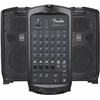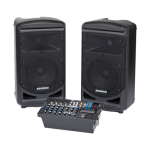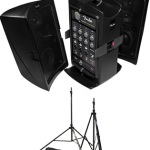
3 Questions to Help You Understand New FCC Rules
FCC wireless mic restrictions, although in place since last year, officially take effect on January 5, 2011!
In 2010, the FCC reallocated the entire 698-806 MHz UHF frequency range for use by emergency responders and wireless devices such as smart phones and PDA’s.
Some wireless microphone systems, which had operated in this bandwidth in the so-called ‘white spaces’ – spaces in the UHF spectrum between broadcast TV channels – were forced to vacate these frequencies to comply with the law.
Problem solved, right?
Easier said than done. Many users of wireless mic systems were faced with a hefty re-investment in new equipment. But the shifting of devices – licensed and unlicensed – to different bandwidths leads to another problem.
The lower UHF frequencies now face unprecedented crowding not only by existing unlicensed devices, but also devices that haven’t even been invented yet. What’s more, the FCC craves even further bandwidth to make room for the National Broadband Program.
How will this affect those using wireless microphones in their theater, business or house of worship?
Learn more about the changing legal landscape of the wireless spectrum – and what might be in store in the future for wireless mic users – with these answers to 3 common questions on FCC wireless mic regulations.
1. What frequencies can I legally use for my wireless mic system?
Unlicensed wireless mic, monitoring, and intercom systems are allowed to continue to use any VHF or UHF band not currently claimed by a local TV station or public safety agency.
Wireless operators that deploy a large number of systems, such as for large events, are required to check a geo-location database to insure they don’t interfere with existing systems. Unfortunately, this database has yet to be developed, and is not expected to appear until mid-2011.
For now, devices that utilize reserved TV channels are not available for sale.
Until they are, it’s enough to research your local market to avoid the channels occupied by TV and public safety agencies. Many microphone manufacturers such as Shure supply this information to their customers via software or other resources.
2. What can I do with my old microphone system?
If your microphone operates on the VHF bandwidth, or if it operates on any UHF frequency besides 698-806 mHz, you’ve got nothing to worry about.
Possible penalties for operating in the forbidden frequency range include equipment confiscations and large fines – potentially in the $10,000 range.
Although the chances of getting caught could be slim, the potential for financial liability is such that many users are ditching their old mics in favor of new, FCC compliant systems.
But don’t ditch your old 700mHz mic system wholesale.
The only wireless microphone system components affected by FCC rules are transmitters and receivers. This means that everything else- lapel mics, headset mics, mic clips, stands, etc. – may still be compatible with your new system. Holding on to these components could save you hundreds of dollars, especially if you have a large system.
3. How do I know future rulings won’t affect my wireless mic system?
The short answer is that you don’t.
Yet another proposed spectrum reallocation will free up an additional 500 MHz of bandwidth- all to be auctioned off by the FCC to the highest bidder. These new frequencies will come from government agencies and private license holders alike.
According to the White House, “There will be new opportunities for innovation through free, unlicensed use of spectrum by technology start-ups, individual users, and others.” But the shift could affect TV stations (for whom moving their broadcast frequencies has already cost mass sums of money) and possibly unlicensed device users as well.
It remains to be seen how the National Broadband Plan will impact wireless mic use. Fortunately, wireless manufacturers – as well as we at AudioLinks – are keeping a close watch on this situation, and will inform our clients as the rules change.
Email us or call 407-757-3326 to find an FCC compliant wireless mic system that’s ideal for you and your budget.


